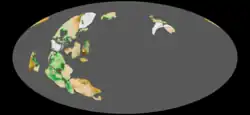| Calymmian | |||||||||
|---|---|---|---|---|---|---|---|---|---|
 Paleoglobe of the Earth at the start of the Calymmian, c. 1590 Ma | |||||||||
| Chronology | |||||||||
| |||||||||
| Etymology | |||||||||
| Name formality | Formal | ||||||||
| Usage information | |||||||||
| Celestial body | Earth | ||||||||
| Regional usage | Global (ICS) | ||||||||
| Time scale(s) used | ICS Time Scale | ||||||||
| Definition | |||||||||
| Chronological unit | Period | ||||||||
| Stratigraphic unit | System | ||||||||
| Time span formality | Formal | ||||||||
| Lower boundary definition | Defined chronometrically | ||||||||
| Lower GSSA ratified | 1991[1] | ||||||||
| Upper boundary definition | Defined chronometrically | ||||||||
| Upper GSSA ratified | 1991[1] | ||||||||
The Calymmian Period (from Ancient Greek: κάλυμμα, romanized: kálymma, meaning "cover") is the first geologic period in the Mesoproterozoic Era and lasted from 1600 Mya to 1400 Mya (million years ago). Instead of being based on stratigraphy, these dates are defined chronometrically.
The period is characterised by expansion of existing platform covers, or by new platforms on recently cratonized basements.
The supercontinent Columbia started to break up during the Calymmian some 1500 Mya.
The Volyn biota have been dated to 1500 Mya.
See also
- Boring Billion – Earth history, 1.8 to 0.8 billion years ago
- Jotnian – Oldest known sediments in the Baltic area that have not been subject to metamorphism
References
- "Calymmian Period". GeoWhen Database. Archived from the original on May 12, 2006. Retrieved January 5, 2006.
- James G. Ogg (2004). "Status on Divisions of the International Geologic Time Scale". Lethaia. 37 (2): 183–199. doi:10.1080/00241160410006492.
- 1 2 Plumb, K. A. (June 1, 1991). "New Precambrian time scale". Episodes. 14 (2): 139–140. doi:10.18814/epiiugs/1991/v14i2/005.
This article is issued from Wikipedia. The text is licensed under Creative Commons - Attribution - Sharealike. Additional terms may apply for the media files.